Hajduk
A hajduk is a type of irregular infantry found in Central and parts of Southeast Europe from the early 17th to mid 19th centuries. They have reputations ranging from bandits to freedom fighters depending on time, place, and their enemies.
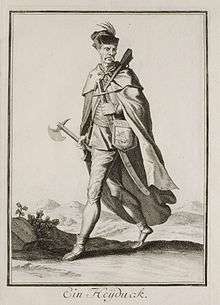
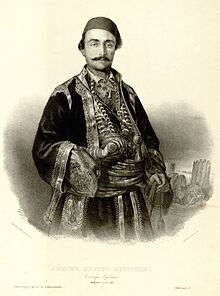
In the European lands of the Ottoman Empire, the term hajduk was used to describe bandits and brigands of the Balkans, while in Central Europe for the West Slavs, Hungarians, and Germans it was used to refer to outlaws who protected Christians against provocative actions by the Ottomans. In the 17th century they were firmly established in the Ottoman Balkans, owing to increased taxes, Christian victories against the Ottomans, and a general decline in security. Hajduk bands predominantly numbered one hundred men each, with a firm hierarchy under one leader. They targeted Ottoman representatives and rich people, mainly rich Turks, for plunder or punishment to oppressive Ottomans, or revenge or a combination of all.[1]
In Balkan folkloric tradition, the hajduk (hajduci or haiduci in the plural) is a romanticised hero figure who steals from, and leads his fighters into battle against, the Ottoman or Habsburg authorities. They are somewhat comparable to the English legend of Robin Hood and his merry men, who stole from the rich (which as in the case of the hajduci happened to be also foreign occupants) and gave to the poor, while defying seemingly unjust laws and authority.
The hajduci of the 17th, 18th and 19th centuries commonly were as much guerrilla fighters against the Ottoman rule as they were bandits and highwaymen who preyed not only on Ottomans and their local representatives, but also on local merchants and travellers. As such, the term could also refer to any robber and carry a negative connotation.[2][3]
Etymology
The etymology of the word "hajduk" is unclear. One theory is that hajduk was derived from the Turkish word haidut or haydut, which was originally used by the Ottomans to refer to Hungarian and Polish-Lithuanian Commonwealth infantry soldiers. Another theory suggests that the word comes from the Hungarian hajtó or "hajdó" (plural hajtók or "hajdók"), meaning a (cattle) drover.[4] Indeed, these two theories do not necessarily contradict each other, as the Balkan word is said to be derived from the Turkish word haiduk or hayduk (bandit).[2][3][5]
Other spellings in English include ajduk, haydut, haiduk, haiduc, hayduck, hayduk.
Forms of the word in various languages, in singular form, include:
- hajdut, in Albanian; in the ordinary sense of "thief"
- hayduk (հայդուկ), in Armenian; used as a male given name, and it means "Armenian freedom fighter".
- hajduk, in Bosnian
- haydut (хайдут), haydutin (хайдутин) or hayduk (хайдук), in Bulgarian
- hajduk, in Croatian
- haidouk, haiduque, in French
- aiducco, in Italian
- hajdú, in Hungarian
- ajduk (ајдук), ajdutin (ајдутин), in Macedonian
- hajduk, in Polish
- Hajduk, in Romani
- haiduc, in Romanian
- hajduk (хајдук), in Serbian
- hajdúch in Slovak
- hejduk, in Swedish
- haydut, in Turkish; in the ordinary sense of "bandit"
- hejduk, in Kurdish
- gajduk (гайдук), in Russian
- haidamaka (гайдамака), in Ukrainian
- haydamak (הײַדאַמאַק), in Yiddish
Irregular military
Kingdom of Hungary
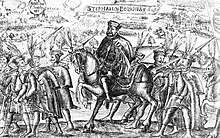
In 1604–1606, István Bocskay, Lord of Bihar, led an insurrection against the Habsburg Emperor, whose army had recently occupied Transylvania and begun a reign of terror. The bulk of Bocskay's army was composed of serfs who had either fled from the war and the Habsburg drive toward Catholic conversion, or been discharged from the Imperial Army. These peasants, freelance soldiers, were known as the hajduk. As a reward for their service, Bocskay emancipated the hajduk from the jurisdiction of their lords, granted them land, and guaranteed them rights to own property and to personal freedom. The emancipated hajduk constituted a new "warrior estate" within Hungarian feudal society. Many of the settlements created at this time still bear the prefix Hajdú such as Hajdúbagos, Hajdúböszörmény, Hajdúdorog, Hajdúhadház, Hajdúnánás, Hajdúsámson, Hajdúszoboszló, Hajdúszovát, Hajdúvid etc., and the whole area is called Hajdúság (Land of the Hajduk) (see Hajdú County).
Polish-Lithuanian Commonwealth
The word hajduk was initially a colloquial term for a style of footsoldier, Hungarian or Turco-Balkan in inspiration, that formed the backbone of the Polish infantry arm from the 1570s until about the 1630s. Unusually for this period, Polish-Lithuanian hajduks wore uniforms, typically of grey-blue woolen cloth, with red collar and cuffs. Their principal weapon was a small calibre matchlock firearm, known as an arquebus. For close combat they also carried a heavy variety of sabre, capable of hacking off the heads of enemy pikes and polearms. Contrary to popular opinion, the small axe they often wore tucked in their belt (not to be confused with the huge half-moon shaped berdysz axe, which was seldom carried by hajduks) was not a combat weapon, but rather was intended for cutting wood.
In the mid-17th century hajduk-style infantry largely fell out of fashion in Poland-Lithuania, and were replaced by musket-armed infantry of Western style. However, commanders or hetmans of the Polish-Lithuanian Commonwealth continued to maintain their own liveried bodyguards of hajduks, well into the 18th century as something of a throwback to the past, even though they were now rarely used as field troops. In imitation of these bodyguards, in the 18th century wealthy members of the szlachta hired liveried domestic servants whom they called hajduks, thereby creating the meaning of the term 'hajduk' as it is generally understood in modern Polish.[6]
Kingdom of Serbia (1718–39)
The Serbs established a Hajduk army that supported the Austrians.[7] The army was divided into 18 companies, in four groups.[8] In this period, the most notable obor-kapetans were Vuk Isaković from Crna Bara, Mlatišuma from Kragujevac and Kosta Dimitrijević from Paraćin.[7]
Cultural influence
The Croatian football team HNK Hajduk Split; Serbian football teams Hajduk Kula, FK Hajduk Beograd, FK Hajduk Veljko and Hajduk Lion; the Macedonian football team FK Hajduk - Vratnica; the pop-music project Haiducii, and Romanian Roma musical troupe Taraful Haiducilor are all named after the hajduci. The surnames of the fictional character George Washington Hayduke, invented by Edward Abbey, actress Stacy Haiduk, US national soccer team defender Frankie Hejduk, Czech Republic national ice hockey team forward Milan Hejduk and Montenegrin theoretical physicist Dragan Hajduković, are likewise derived from this word.
The term "haiduci" was used by the Romanian resistance movement Haiducii Muscelului, between 1947 and 1959, which opposed the Soviet occupation and the Communist government.
In academics
In the early 1970s, after the publication of the now classic sociological studies Primitive Rebels and Bandits by historian Eric Hobsbawm, hajduks started appearing in western social and anthropological literature. Hobsbawm invented the term "social bandit" to describe outlaws who operate on the edges of rural societies by fighting against authorities and sometimes helping the ordinary people. There has always been a degree of fluidity in their status, whereby, as described by John Koliopoulos in his study of Greek klephts, Brigands with a Cause, brigands would sometimes change sides and start acting on behalf of the authorities to preserve peace and suppress banditry, and vice versa.
From the early 1980s, sociological studies started narrating the stories of hajduks, klephts, bandits, brigands, outlaws, rebels, and pirates in all parts of the planet, from Australia to republican China, the Balkans, the American Wild West, Cuba and Mexico.
Hajduk is mentioned in the song "Dragostea Din Tei", most notable for being the basis of the Numa Numa meme.
Notable hajduks
Bulgarian
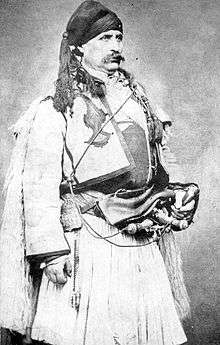
Albanian
- Çerçiz Topulli (1889-1915), important figure during the Albanian National Awakening and Albanian national hero
Romanian
- Iancu Jianu (1787–1842), hajduk in Oltenia, participant of the Wallachian Uprising
- Radu Şapcă (Popa Șapcă, fl. 1848–64), priest and hajduk in Oltenia, participant in the 1848 Revolutions in Wallachia
- Pintea the Brave (Pintea Viteazul, d. 1703), rebel in the area of Maramureș.
- Şaptecai (Anghel Panait)
- Andrii Popa
Greek
- Odysseas Androutsos
- Markos Botsaris
- Athanasios Diakos
- Geórgios Karaïskákis
- Antonis Katsantonis
- Theodoros Kolokotronis
- Dimitrios Makris
- Nikitas Stamatelopoulos
Hungarian
- Angyal Bandi
- Jóska Sobri
- Sándor Rózsa
Ukrainian
Czech/Moravian/Polish/Slovak
- Juraj Jánošík
- Ondráš
- Matěj Ondra z Leskovce
Bosnia and Herzegovina, Croatia, Montenegro and Serbia
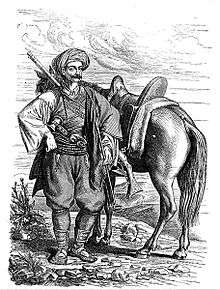
- Starina Novak (1530s–1601), Wallachian-employed guerrilla commander, former peasant in Timok
- Ivo Senjanin (d. 1612), Habsburg Croatian uskok
- Mijat Tomić (1610–1656), brigand leader in Ottoman Bosnia
- Petar Mrkonjić (fl. 1645–69), Venetian-employed guerrilla
- Bajo Pivljanin (fl. 1669–85), Venetian-employed guerrilla leader
- Ilija Perajica (fl. 1685), Venetian-employed guerrilla leader
- Ivan Bušić Roša (1745–1783), Venetian-employed guerrilla leader
- Stanislav Sočivica (1715–1776), brigand leader in Ottoman Bosnia
- Andrijica Šimić (1833–1905), rebel in Herzegovina
- Pecija (1826–1875), rebel leader in Bosnian Krajina
- Stanoje Glavaš, commander in the First Serbian Uprising
- Stojan Čupić, commander in the First Serbian Uprising
- Hajduk Veljko, commander in the First Serbian Uprising
- Jovo Stanisavljević Čaruga (1897–1925), outlaw in Slavonia
- Ivan Musić[9] (1848–1888), duke of Herzegovina, leader of the uprising against the Ottomans.
See also
| Wikimedia Commons has media related to Hajduks. |
- Armatoloi, Ottoman Greek irregulars
- Armenian fedayi, guerillas and irregulars (1880s–1920s)
- Bashi-bazouk, Ottoman irregulars (17th century)
- Brigandage in southern Italy after 1861, bandits in South Italy (1861-65)
- Bushrangers, bandits in Australia (1790s–1900s)
- Early Cossacks, Slavic-Tatar frontier warriors
- Kachaks, Albanian bandits and rebels (1880s–1930)
- Klepht, Ottoman Greek bandits and rebels
- Haidamaka, pro-Cossack paramilitary (18th century)
- Jewish pirates, renegade bandits expelled from the Iberian Peninsula (16th to 18th centuries)
- Rapparee, Irish guerillas (1690s)
- Uskoks, Habsburg Croatian irregulars (1520s–1618)
- Zeybeks, Ottoman irregulars (17th to 20th centuries)
- Hajdučka Republika Mijata Tomića, a micronation
- Hayduke, term used by environmental activists
References
- Gabor Agoston; Bruce Alan Masters (21 May 2010). Encyclopedia of the Ottoman Empire. Infobase Publishing. p. 252. ISBN 978-1-4381-1025-7.
- Найден Геров. 1895-1904. Речник на блъгарский язик.Хайдукъ
- Л.Андрейчин и др. 2006. Български тълковен речник. Четвърто издание
- Petrović, Aleksandar. These persons become later soldiers at the Hungarian-Ottoman Serbian border and fight against the Ottoman Turks. The Role of Banditry in the Creation of National States in the Central Balkans During the 19th Century Archived 2013-08-01 at the Wayback Machine
- Младенов, Стефан. 1941. Етимологически и правописен речник на българския книжовен език
- Richard Brzezinski, Polish Armies 1569-1696, volume 1, London: Osprey Military Publishing, 1987, p. 21, 39-41 (also contains six contemporary illustrations of Polish hajduks, besides several modern reconstructions by Angus McBride).
- Душан Ј Поповић (1950). Србија и Београд од Пожаревачког до Београдског мира, 1718-1739. pp. 42–43.
- Radovan M. Drašković (1987). Valjevo u prošlosti: prilozi za zavičajnu istoriju. "Milić Rakić". p. 22.
Хајдучка војска била је подељена на 18 компанија, које су се распореЬивале у 4 групе.
- hr:Ivan Musić
Further reading
- Suvajdžić, Boško (2003). "Hajduci i uskoci u narodnoj poeziji: Istorijske pretpostavke za nastanak i razvoj hajdučkog pokreta" (in Serbian). Janus; Rastko. Archived from the original on 2016-03-22.
External links
| Wikisource has the text of the 1911 Encyclopædia Britannica article Haiduk. |